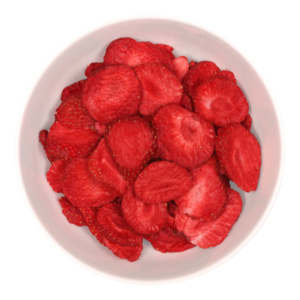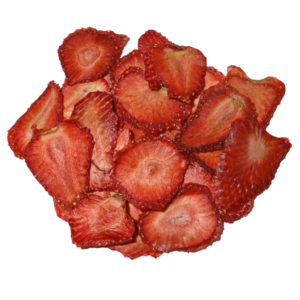Our 3 Favorite Things About Freeze-Dried Strawberries

1. They’re packed with vitamin C (and other nutrients)
Ounce for ounce, fresh strawberries actually have more vitamin C than oranges. You can get more vitamin C from just eight strawberries than you get in an entire orange. They’re also rich in fibre and antioxidants. But what’s the best way to make strawberries more portable without sacrificing critical nutrients? Freeze-drying. It’s the only method that locks in vitamin C and vitamin A (both of which degrade quickly when dried in a traditional dehydrator), yet also gives you a healthy snack that’s truly shelf stable. Additionally, because freeze-dried fruit comes from frozen fruit, which retains more of the original nutrition than fresh, the freeze-drying process retains all of that goodness. That means you can stash them away in your car, diaper bag, desk drawer, or just about anywhere and be assured of a snack that’s healthy and nutritious as well as convenient.
2. They’re nature’s indulgent healthy
 snack
snack
People eat too much sugar. Packaged food manufacturers put way too much sugar into their products, sneaking it into foods like crackers and peanut butter. Even condiments such as ketchup are laden with sugar these days. At Mercer, we believe great food doesn’t need to be full of additives to be delicious. And we’re proven right every day when consumers choose our products. Healthy snacks are only effective if people love to eat them. Thankfully, fresh strawberries are already delicious. But by freeze-drying the fruit, we can create an entirely new snack with a satisfying texture.

3. They’re ready to eat year-round
[su_column]We’re thrilled each summer when strawberry season rolls around. Unlike fresh strawberries — which are notoriously delicate and have a short growing season and no shelf life — freeze-dried berries are always in season. And freeze-dried strawberries offer an equally pleasant experience. The crispy, crunchy texture makes them perfect for adding to cereal, sprinkling on top of yoghurt, or eating right out of the bag. Wherever you are, whatever you’re doing, freeze-dried strawberries offer a healthy, delicious snack. Ready to kickstart more healthy habits? Make the transition easy on yourself. Start by keeping a bag of freeze-dried strawberries wherever you go.[/su_column][su_divider style=”dotted”]




